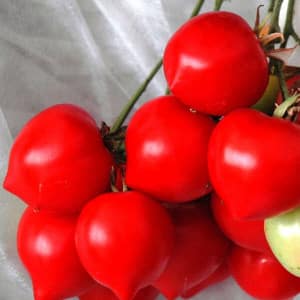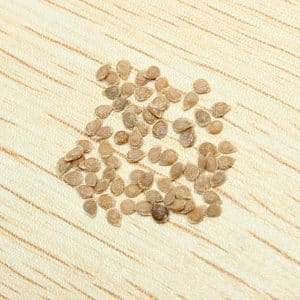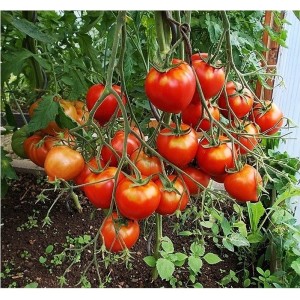Hybrid recommended by summer residents - tomato Tarasenko 2 and its positive qualities
Every gardener wants to plant tomatoes on their plot that will have excellent taste, bear fruit for a long time and produce a good harvest. Among the crops with such properties is the Tarasenko-2 hybrid. This article will tell you about its advantages over other tomatoes, preparation for planting, care and cultivation.
Description
Tarasenko-2 tomatoes are the most popular of their series. They were bred by amateur vegetable grower Theodosius Tarasenko many decades ago, but are still in demand among gardeners.
In the description of varieties and hybrids from Tarasenko’s numerous series, a wide variety of characteristics are found. Tarasenko-2 is distinguished by stable immunity to diseases and high yield rates.
Distinctive features

The bushes of the hybrid vegetable crop are tall: they can grow to a height of 1.8 to 2.2 m. Tomatoes grow on the ground and in a greenhouse.
Fruit characteristics, yield
The plant has up to 9 fruiting clusters, each of which bears up to 7 fruits. Each fruit weighs from 80 to 100 g. Tomato fruits are red-orange in color, have a round, smooth shape with a spout at the base of the fruit.
They are suitable for preparing salads, do not crack after heat treatment and are suitable for whole-fruit canning. Up to 15 kg of fruits are collected from one bush.
How to grow seedlings
F. Tarasenko proposed his technology for cultivating a new crop from the moment of sowing seeds for seedlings. The main principle is to increase the productivity of tomatoes thanks to a developed root system.
During growth, the roots of the Tarasenko 2 variety can go 1.5 m deep into the soil. Therefore, the comfort of the crop must be taken care of in advance.
Seed preparation
To prepare seeds for sowing, it is necessary to follow the selection rules.
Seeds for seedlings have the following criteria:
- correspond to one selected variety;
- have no impurities;
- one size.
Seeds with traces of diseases, incorrect coloring, or spoiled cannot be used. Tomatoes are susceptible to various diseases, so it is better to treat and disinfect them before planting.
To disinfect seeds, it is recommended to use one of the following methods:
- Soak the seeds in a concentrated solution of manganese for 25 minutes, then rinse them in clean water;
- crush the unpeeled garlic, add the seeds, place in a jar with a tight lid and leave for 1 hour, then rinse with water and dry;
- Place the seeds in a solution prepared from 1 liter of water and 20 g of ash and let it brew for 4-6 hours, then rinse and dry the seeds.
Attention! With hybrid seeds treated by the manufacturer, it is not necessary to carry out the above procedures.
Next, seeds using this method:
- Place a cotton cloth or paper napkin at the bottom of a shallow plate or other container.
- Carefully place the seeds in a shallow dish on top of a lined cloth or paper.
- To create the required temperature and humidity, cover the dish with a lid and place it in a warm place for 15 hours.
- The swollen seeds are transplanted into the ground to produce seedlings.
Important. Treated seeds must be planted in the ground within 24 hours, otherwise they will spoil.To shorten the germination time, the seeds are moistened with water at room temperature and left for 24 hours to absorb moisture.
Container and soil
Tomatoes are sown as seedlings 65 days before planting the plants in the ground. The container for planting is chosen as standard, but it must be wide enough.
Light and loose soil that drains water well is suitable. It is not difficult to make such soil yourself, using peat or sawdust as an additive - such impurities are rich in minerals. The presence of clay in soil and mixtures should not be allowed.
Sowing
There are requirements for sowing:
- make boxes for seedlings with a depth of at least 6 cm;
- fill the containers with treated soil so that there is 2 cm left to the edge of the box (it is recommended to buy soil in the store to avoid tomato diseases);
- spread the seeds on the ground, 1 piece at a time. per 1 cm²;
- cover the seeds with a 1 cm layer of soil.
Growing and care
The development and growth of seedlings depend on care. After sowing seeds, it is necessary to regularly check the moisture content of the soil mixture, ventilate the containers and remove perspiration from the lid with a cotton napkin.
When the first shoots appear, after 4-10 days (depending on whether they were planted dry or germinated), the boxes with seedlings are placed on the windowsill so that the sun's rays fall on the young plant and reduce the air temperature. After the seedlings have leaves (at least two), you need to remove the final part of the taproot and plant the tomatoes in separate deep containers.
Further plant care:
- monitor the air temperature, light, and humidity in the room;
- water on time;
- fertilize the soil.
Before planting the soil, it is advisable to harden the seedlings.
How to grow tomatoes
Tarasenko-2 tomatoes have a powerful root system that grows to great depths. Therefore, when growing tomatoes, F. Tarasenko used his own methodology.
Landing
In prepared, treated and fed holes at the end of the year, plant seedlings, 2 bushes in each hole. The recess measures approximately 50x50 cm, 44 cm deep. Distance for good growth and development of tomatoes: at least 1 m between plants, 1.5 m between rows.
Care
After transplanting the plants into the soil, the following care measures are taken:
- Cover with soil and water with warm water and manganese. To prepare the solution, you need to dilute 1.5 g of manganese in 5 liters of water.

- Excess sprouts are removed from growing tomatoes (stepson), tied to a support. This is done so that the bushes are ventilated and receive sunlight.
- When the first tomatoes appear, cut off or tear off the lower leaves.
- Water The plant requires a sufficient amount of water weekly. Make sure the soil is loose.
- Feeding done 2 weeks after transplanting into the ground. When the fruits appear, fertilize the tomatoes again, and after 3 weeks the procedure is repeated.
After planting in the ground in the first 2-3 weeks, it is recommended to loosen the soil to 10-12 cm in depth. Next, the soil is loosened by 5-8 cm so as not to damage the roots. Heavy soil is loosened deeper, to the place where the roots of the plant have not yet penetrated. Improves soil temperature and humidity mulching.
It is better to loosen the soil between the rows along with weeding and at least once every two weeks. It is better to loosen overgrown tomatoes and hill them up immediately. Hilling creates favorable conditions for warming the soil and does not allow the roots to be exposed.The first procedure is done 2-3 weeks after planting in the ground, the next - after 2 weeks. It is useful to carry out hilling together with the addition of humus.
Features of cultivation and possible difficulties
Tomatoes love fertile soil. If tomatoes grow in sandy soil, more soil moisture and the addition of humus or manure are required. Tomatoes have difficulty tolerating excess water in the ground: it interferes with air access to the roots of the plant.
It’s good if, where tomatoes grow, cucumbers, peas, carrots, cabbage, and herbs grew before. It is not recommended to plant tomatoes on the soil where potatoes grew, as they may become infected with fungi or diseases of the nightshade family. It is advisable to deeply plow the soil in the fall and fertilize it with manure at the rate of 3 kg per 1 m².
Tarasenko 2 tomatoes have the same growing difficulties as other hybrids.
The most common:
- leaf color with defects due to sudden changes in temperature after planting seedlings in the ground;
- non-infectious putrefactive lesions are caused by a lack of calcium, excess moisture, which can destroy the plant;
- sunburn;
- cracked fruits from excess water in the fruits with accelerated growth or overripeness;
- the plant does not bloom - may be caused by a sharp cold snap or lack of moisture.
Diseases and pests
Tarasenko-2 tomatoes are little susceptible to diseases. They are highly resistant to diseases such as:
- tobacco mosaic virus;
- late blight;
- altracnose;
- verticillium.
Gardeners do not even take preventive measures to combat diseases. Tarasenko himself recommended treating plants for preventive purposes on cold summer days and during long rains.It is better to treat with a 1% Bordeaux solution prepared at home (copper sulfate and slaked lime).
Common pests among tomatoes: Colorado potato beetle, mole cricket, whitefly, bugs, nematode. It is more effective to combat them with the help of fungicides.
The nuances of growing in open ground and in a greenhouse
Growing tomatoes in a greenhouse is slightly different from growing them in open soil. Conditions that need to be controlled when growing tomatoes in a greenhouse:
- air temperature and lighting;
- humidity, room ventilation;
- presence of carbon dioxide;
- plant water consumption standards;
- loosening, weeding, watering bushes.
At the beginning of August, flowers and ovaries, tops and side shoots are removed from the bushes. Water and feed for the last time, pick off small green fruits for rapid ripening of large-sized fruits.
In open ground, seedlings are planted in late May or early June so that the soil has already warmed up.
Harvesting and application
Tarasenko-2 tomatoes ripen quickly. This occurs 3 months after planting in open ground or in a greenhouse. Even not quite ripe tomatoes are harvested. If they are stored in a cool place, they ripen quickly and can be stored until winter.
Delicious salads are prepared from tomatoes, they are pickled and canned, and they are made into juice.
Advantages and disadvantages
The main advantages of the hybrid:
- has a sweetish taste, fleshy pulp;
- adapts well to the environment;
- fruits can hang on the branches for a long time without losing quality;
- resistance to various diseases;
- long storage of fruits after harvesting.
The only drawback is that tomatoes need to be fed and tied up.
Other Tarasenko hybrids
The series is represented by options:
- Tarasenko 6. Medium ripe tomatoes. Fruits until early autumn. Plant up to 1.5-2 m tall. The fruits are plum-like and bright red in color. One tomato weighs up to 350 g.
- Tarasenko 7. Tomatoes weighing from 100 to 200 g.
- Anniversary. The liana-shaped branches of the bushes reach a length of 3 m. A harvest of up to 5 kg is obtained from one bunch. One fruit weighs 200 g. The shape of the tomato is similar to a heart with an elongated top.
- Nadiya. Externally they resemble a plum, bright red in color. Fruit weight 100-120 g.
- Combitomat. Bright red tomatoes weighing up to 180 g.
- Gift to Polesie. Orange-red tomatoes weighing 100 g.
All hybrids of the Tarasenko series have similar yield indicators.
Farmer reviews
Irina, Astrakhan: «I've been growing tomatoes for a long time. Of all, I prefer Tarasenko 2. They are tasty, with thin skin. It’s convenient to roll them into jars to have quality canned tomatoes in winter. Even after heat treatment, they do not crack—you can take photos for the culinary community on the Internet.”
Alexander, Krasnodar: “I love this variety. Because they do not require special care, except for tying up the bushes, loosening the soil and watering. Every autumn I get a rich harvest, which is stored in the basement for a long time. The taste is excellent, the pulp is sugary. My gardening friends also love these tomatoes and praise their taste.”
Svetlana Anatolyevna, Voronezh: “The main thing is that this hybrid does not suffer from various diseases. There is no need to frequently spray them with pesticides or constantly monitor pests that destroy seedlings, fruits, and adult plants. In the fall, I harvest an excellent harvest, store it on the balcony, and get great pleasure from tomato salads and canned tomatoes from a jar.”
Conclusion
In many respects, Tarasenko-2 tomatoes are superior to other crops. The hybrid is especially popular among experienced gardeners, who find many advantages and advise every summer resident to have this wonderful vegetable on their plot.